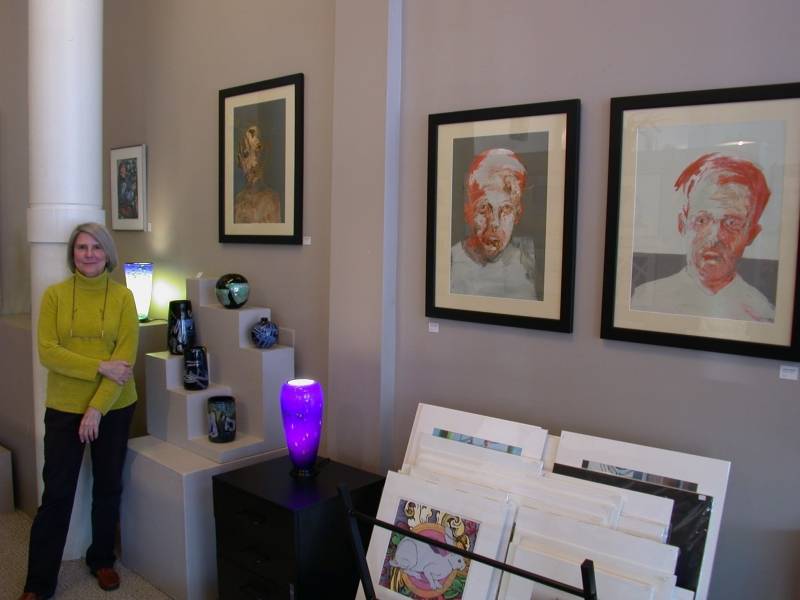Smile Politely pretty much exists to tout the benefits of our amazing micro-urban community, and especially coming off of BEST week, it’s easy to look around and see the wealth. Hearing the news about Figure One closing hit me hard, however, even though I understand it is a part of the university and therefore yet another casualty of Springfield. As a long-term resident of C-U, it’s hard not to see them as another passenger in the revolving-door which appears to be our local fine art market. On a closer look, however, some local professionals helped me to see that the same things that make our community unique in other artistic areas also help provide different opportunities for purchasing art.
One of the most obvious examples is that the overflow from Boneyard Arts Festival can sometimes seem to last all year. Although there is a concerted effort to bring new art into unexpected venues during mid-April, these exhibitions can stay up for months, generating attention and sales for the featured artists. I’ll admit, there are times when I become aware that I’ve stopped paying attention to whatever’s hanging in Kopi, or Circles, or Cafeteria & Co. I love that I’m spoiled for choice in these situations, saying “Ho, hum, more art in a coffeeshop”, but during my day-to-day, I’m not always thinking about decorating my walls or adding to my art collection. Still,  the opportunity is there, and often quite available. Kelly White, executive director of 40 North told me that recently, “We have attempted to put more of a focus on the fact that a lot of the work displayed during Boneyard is for sale (some venues fare much better than others) but the mission of the festival is on a much broader scale.” By all means, just immersing the community in quality local art is definitely worth it.
the opportunity is there, and often quite available. Kelly White, executive director of 40 North told me that recently, “We have attempted to put more of a focus on the fact that a lot of the work displayed during Boneyard is for sale (some venues fare much better than others) but the mission of the festival is on a much broader scale.” By all means, just immersing the community in quality local art is definitely worth it.
Another long-standing trend in C-U is the combined gallery-business. The Art Coop Gallery is nestled inside the Lincoln-Square retailer of quality art supplies, and Lola’s Brush, the painting-party organizers, also houses Gallery 217. International Gallery and Framer’s Market both offer framing in addition to selling original artwork and prints by local artists. [co][lab] has begun hosting exhibitions in its front area, open any hours that people are working, but then you’re looking at art in the same place people are working. The duality of this business model is certainly practical, but it seems that the secondary business may overshadow the fact that these businesses  actually show. Until writing this article, I had no idea about the Art Coop or Framer’s Market offering original works, but learned about them by speaking with Pauline Tannos, Public Arts Coordinator for the City of Urbana, who continued, “I think these businesses are cool because they’re not your traditional galleries, but they experiment with what can be done, and they do that well.” I’ll have to give them a closer look in the near future.
actually show. Until writing this article, I had no idea about the Art Coop or Framer’s Market offering original works, but learned about them by speaking with Pauline Tannos, Public Arts Coordinator for the City of Urbana, who continued, “I think these businesses are cool because they’re not your traditional galleries, but they experiment with what can be done, and they do that well.” I’ll have to give them a closer look in the near future.
I reached out to Pauline because she co-organized the inaugural Urbana Art Expo last fall with 40 North. The UAE was held in the Civic Center, and really straddled the line between street-fair and fine art gallery show. The Chair of the Public Arts Commission proposed the idea, and Tannos met with some Urbana-based artists who primarily focused on selling online and had never actually sold a work of art to a local customer. I found this disturbing, but the experience was echoed by Cinema Gallery owner Carolyn Baxley. “I think both our cities need to make more of an effort to get residents to Buy Local and not drive to Chicago or Indy or St. Louis to buy art. The artists who have roots in Champaign-Urbana are among the very best in the country, […] often the very best artwork can be found in their backyard.”

 The Cinema is one of the the few curated galleries in town which has succeeded long-term, and Carolyn has worked for 15 years to establish a loyal customer base, even attracting people from those larger cities who make the trip down here to take advantage of our offerings from talented artists of all ages in our community. It’s that larger population that she fears makes the difference in establishing a formal gallery. As the owner of her building, she can focus on the gallery without the same worries as other
The Cinema is one of the the few curated galleries in town which has succeeded long-term, and Carolyn has worked for 15 years to establish a loyal customer base, even attracting people from those larger cities who make the trip down here to take advantage of our offerings from talented artists of all ages in our community. It’s that larger population that she fears makes the difference in establishing a formal gallery. As the owner of her building, she can focus on the gallery without the same worries as other  businesspeople. Gallery 217, mentioned above, is also moving into holding more curated exhibitions with formal gallery openings, but is on hiatus during the summer. A newer development is the exhibition of juried shows at 40 N’s new space, 40 Point One, inside the Champaign Telephone Company. White describes it as a space with “perfect lighting, clean white walls for the art to breathe – and I am beyond thrilled to have a space dedicated to local juried art shows. It’s a
businesspeople. Gallery 217, mentioned above, is also moving into holding more curated exhibitions with formal gallery openings, but is on hiatus during the summer. A newer development is the exhibition of juried shows at 40 N’s new space, 40 Point One, inside the Champaign Telephone Company. White describes it as a space with “perfect lighting, clean white walls for the art to breathe – and I am beyond thrilled to have a space dedicated to local juried art shows. It’s a  step in a wonderful direction.” The other professionally curated gallery in town is the IMC, which operates as part of a non-profit organization although the works displayed are for sale. That curation definitely makes a difference to artists, says Tannos, because it “look[s] better on a résumé, and gallery representation can help artists connect with buyers that are outside of their reach. For these reasons, I don’t think traditional galleries can be replaced completely.”
step in a wonderful direction.” The other professionally curated gallery in town is the IMC, which operates as part of a non-profit organization although the works displayed are for sale. That curation definitely makes a difference to artists, says Tannos, because it “look[s] better on a résumé, and gallery representation can help artists connect with buyers that are outside of their reach. For these reasons, I don’t think traditional galleries can be replaced completely.”
 Perhaps not, but similar to the above galleries which do not need to rely solely upon art sales to survive, there’s another alternative in town: galleries which offer art as an experience. The Institute 4 Creativity and the Outhaus both seek to provide opportunities to view art without focusing on sales. As artist and father Jorge Lucero said about his children’s recent exhibition at the Outhaus, Don’t Touch Me, I Have Medicine, none of the artwork was specifically for sale, but he bet the kids wouldn’t refuse. As it was, I witnessed the sale of one fragment of the collage, right as I walked in that evening. Urbana’s Artist of the Corridor would readily sell the works it displays, should there be an inquiry.
Perhaps not, but similar to the above galleries which do not need to rely solely upon art sales to survive, there’s another alternative in town: galleries which offer art as an experience. The Institute 4 Creativity and the Outhaus both seek to provide opportunities to view art without focusing on sales. As artist and father Jorge Lucero said about his children’s recent exhibition at the Outhaus, Don’t Touch Me, I Have Medicine, none of the artwork was specifically for sale, but he bet the kids wouldn’t refuse. As it was, I witnessed the sale of one fragment of the collage, right as I walked in that evening. Urbana’s Artist of the Corridor would readily sell the works it displays, should there be an inquiry.  Primarily, I4C has been focused on teaching and being an all-ages venue, but there have been some performance art events that resulted in original artwork being created. A gallery that is uniquely blending this experiential aspect with the focus on selling artwork is The Basement Gallery, which takes secrecy and exclusivity to another level, then delivers an enjoyable house party atmosphere.
Primarily, I4C has been focused on teaching and being an all-ages venue, but there have been some performance art events that resulted in original artwork being created. A gallery that is uniquely blending this experiential aspect with the focus on selling artwork is The Basement Gallery, which takes secrecy and exclusivity to another level, then delivers an enjoyable house party atmosphere.
Even with this town’s reputation for being a viable source of major-league musical and artistic talent, one question I had was whether art by local artists is of the quality I want to buy to add to my collection. There are certainly sources who have encouraged purchasing “emerging artists” and graduate work. While everyone quoted in those (really old) articles admits it is a risk, I’ll tell you in ten years how much this bag of coffee featuring a limited-edition Langston Allston original is worth. The same is true as it is with music, you never know who is going places, but one thing you do know is that your dollars now will help pave the way. That CD you bought at the house show just put some gas in the touring band’s tank, and the 4×6 canvas I bought off Neurotik at least gave him enough to buy some more paint pens. To boot, that painting cost about as much as a ticket to a show plus an album from the merch table.
When you think of it that way, buying work from local artists is even more attractive. Kelly White poses the thought that “there is nothing like owning a piece of original art. I always try to encourage anyone that is buying a manufactured item at a chain store to first ask yourself if there is a local artist/artisan that makes something that would fulfill the same purpose.” Pauline Tannos thinks of it as a personal relationship, saying, “When you purchase a piece of art, you basically take home a piece of someone else’s heart and soul. It’s very rewarding to share that kind of connection with someone.” Carolyn Baxley agrees, “If you mean as an investment in the career of the artist and in the well-being of the visual arts in our community, then by all means people should make that ‘investment.’ But the question I hate most from a potential buyer is ‘What will this be worth in XX years?’ You should buy art because you love it and because it speaks to you in ways that nothing else can—not because you think you’ll make money on it if you sell it a few years down the road.”
So when you move into your new place in two weeks, take a look at what kind of wallspace you have, and consider one of the many ways you could pursue investing in some local talent. And if you haven’t moved in a while, maybe it’s time to refresh both your decor and its source. Think local.








